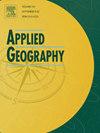了解地表日温度范围的空间分布和非线性驱动因素:来自ECOSTRESS和可解释机器学习的见解
IF 5.4
2区 地球科学
Q1 GEOGRAPHY
引用次数: 0
摘要
城市化和气候变化显著影响城市热环境,特别是日温差及其极限,直接影响城市热舒适和公众健康。尽管它们很重要,但不同城市景观中DTR的空间变异性和潜在驱动因素仍未得到充分探讨。在这项研究中,我们利用来自ECOSTRESS的高分辨率热红外图像来研究最高(Tmax)和最低(Tmin)地表温度的空间格局,以及与自然、物理和人为因素相关的DTR。以韩国首尔为研究对象,我们应用了一个使用广义可加模型(GAMs)和可解释人工智能(XAI)的比较建模框架来捕捉环境变量与DTR之间的非线性关系。我们的研究结果表明,城市地区的DTR明显高于自然景观,这主要是由相对于Tmin的Tmax升高驱动的。研究发现,靠近森林和水体等自然特征可以通过降低Tmax和稳定Tmin来减轻DTR。建筑形态在方向、幅度和阈值方面表现出强烈的非线性效应,水平膨胀增加DTR变异性,垂直致密化抑制DTR变异性。这些见解强调了有针对性的城市规划战略的必要性,以管理与日间地表快速加热相关的不断加剧的DTR。本文章由计算机程序翻译,如有差异,请以英文原文为准。
Understanding the spatial distribution and nonlinear drivers of the diurnal surface temperature range: Insights from ECOSTRESS and explainable machine learning
Urbanization and climate change significantly influence urban thermal environments, particularly the diurnal temperature range (DTR) and its limits, which have direct implications for thermal comfort and public health. Despite their importance, the spatial variability and underlying drivers of DTR across heterogeneous urban landscapes remain underexplored. In this study, we leveraged high-resolution thermal infrared imagery from ECOSTRESS to investigate spatial patterns in maximum (Tmax) and minimum (Tmin) surface temperatures, as well as DTR, in relation to natural, physical, and anthropogenic factors. Focusing on Seoul, South Korea, we applied a comparative modeling framework using generalized additive models (GAMs) and explainable artificial intelligence (XAI) to capture the nonlinear relationships between environmental variables and DTR. Our findings reveal that urban areas exhibit significantly higher DTR than natural landscapes, primarily driven by elevated Tmax relative to Tmin. Proximity to natural features such as forests and water bodies was found to mitigate DTR by reducing Tmax and stabilizing Tmin. Building morphology demonstrated strong nonlinear effects in terms of direction, magnitude, and threshold, with horizontal expansion increasing DTR variability and vertical densification dampening it. These insights highlight the need for targeted urban planning strategies to manage the intensifying DTR linked to rapid daytime surface heating.
求助全文
通过发布文献求助,成功后即可免费获取论文全文。
去求助
来源期刊

Applied Geography
GEOGRAPHY-
CiteScore
8.00
自引率
2.00%
发文量
134
期刊介绍:
Applied Geography is a journal devoted to the publication of research which utilizes geographic approaches (human, physical, nature-society and GIScience) to resolve human problems that have a spatial dimension. These problems may be related to the assessment, management and allocation of the world physical and/or human resources. The underlying rationale of the journal is that only through a clear understanding of the relevant societal, physical, and coupled natural-humans systems can we resolve such problems. Papers are invited on any theme involving the application of geographical theory and methodology in the resolution of human problems.
 求助内容:
求助内容: 应助结果提醒方式:
应助结果提醒方式:


